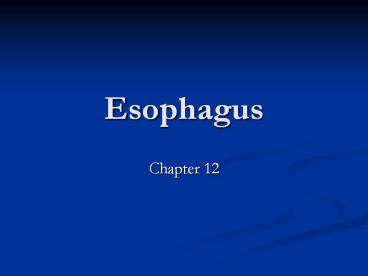Esophagus - PowerPoint PPT Presentation
Title:
Esophagus
Description:
Esophagus Chapter 12 ESOPHAGUS Objectives Anatomy and Physiology GERD and Hiatal Hernia Esophageal Dysmotility Esophageal Diverticula Benign Esophageal Neoplasms ... – PowerPoint PPT presentation
Number of Views:547
Avg rating:3.0/5.0
Title: Esophagus
1
Esophagus
- Chapter 12
2
ESOPHAGUSObjectives
- Anatomy and Physiology
- GERD and Hiatal Hernia
- Esophageal Dysmotility
- Esophageal Diverticula
- Benign Esophageal Neoplasms
- Malignant Neoplasms
- Esophageal Trauma
3
ANATOMY
- 3 Segments
- Cervical esophagus
- Thoracic esophagus
- Abdominal esophagus
- Anatomic Relationships
- Trachea
- Aorta
- Vagus nerve
4
ANATOMY
- Wall
- Mucosa
- stratified squamous epithelium
- goblet cells
- 2 muscular layers
- Inner circular
- Outer longitudinal
- upper 1/3 is skeletal lower 2/3 is smooth muscle
5
ANATOMY
- Upper esophageal sphincter (UES)
- Cricopharyngeus muscle
- Lower esophageal sphincter (LES)
- Zone of high pressure 3-5 cm long
- Intrinsic muscular tone
- Diaphragmatic crura
- phrenoesophageal ligament
- intrabdominal pressure
6
PHYSIOLOGY
- Food enters the back of the oropahrynx
- Coordinated peristaltic wave
- Primary
- Secondary
- Relaxation of the LES
7
GERD
- Gastroesophageal Reflux Disease
- Reflux of acid and bile into the esophagus
- Abnormal clearance from the esophagus
- Resulting erosion and ulceration of mucosal wall
- Scarring and stricture formation
8
GERD Pathophysiology
- Abnormal clearance of acid
- peristaltic wave
- Saliva
- Abnormal relaxation of the LES.
- Low resting pressures
- shortened abdominal segment
9
GERD Pathophysiology
- Abnormalities in the gastric reservoir
- delayed gastric emptying
- gastric dilation
- increased intragastric or abdominal pressure
- gastric hypersecretion
10
GERDPathophysiology
- Hiatal Hernia
- Type I Sliding hernia- movement of
gastroesophageal junction - shortens abdominal segment
- surgery required if sx and unresponsive to
medical mgmt
11
GERDPathophysiology
- Type II Paraesophageal hernia- no movement of GE
junction - usually no reflux
- surgery is required.
12
GERDEtiology
- Decreased resting LES pressure
- alcohol
- cigarette
- chocolate
- caffeine
- medsnitrates, calcium channel blockers, MSO4
derivatives
13
GERDEtiology
- Increased abdominal pressures
- pregnancy
- obesity
14
GERDClinical presentation
- Burning epigastric or substernal pain
- Intensity of pain is often positional
- Dysphagia
- H/O chronic aspiration bronchitis or pneumonitis
- Often relieved by antacids
15
GERDDiagnostic Tests
- Esophagoscopy and biopsy
- Barium Swallow
- Manometry
- pH Monitoring- 24 Hr
- Hemocult
16
GERDTreatment
- Medical
- change habits
- Avoid eating within several hours of sleeping
- Sleep with head of bed elevated
- Weight loss
- Meds antacids, H2 Blockers, Proton pump
inhibitors(lt6 months)
17
GERDTreatment
- Surgical
- Nissen Fundoplication
- Toupet
- Belsey Mark IV
- Collis Gastroplexy
- Hill Repair
- Laparoscopy
18
ESOPHAGEAL MOTILITY DISORDERS
- Achalasia
- Diffuse esophageal spasm
- Nutcracker esophagus
- Hypertensive LES
19
ESOPHAGEAL MOTILITY DISORDERSAchalasia
- Failure To Relax
- Pathophysiology
- Neuronal degeneration in the myenteric plexus of
the esophageal wall - Causes aperistalsis and proximal dilatation
- Presentation
- Dysphagia
- Weight loss
- Regurgitation of undigested food
20
ESOPHAGEAL MOTILITY DISORDERSAchalasia
- Diagnosis
- Cineradiography-Barium swallow
- Birds Beak appearance
- Manometric studies
- Treatment
- Medical
- Balloon Dilatation
- Surgical
- Myotomy
- Partial wrap
21
ESOPHAGEAL DIVERTICULA
- Def outpouching of the wall
- Zenkers Diverticula
- occur between thyropharyngeus and cricopharyngeus
muscles - sx with regurgitated food
- Treatment Diverticulectomy and myotomy
- Epiphrenic Diverticula- Distal 1/3
- As result of other abnormalities-achalasia,
strictures, tight fundoplications
22
Esophageal Neoplasm
- Benign neoplasms- rare
- Leiomyomas
- Malignant Neoplasms
- Squamous cell Carcinoma- 85
- Adenocarcinoma- 10
- Malignant Melanoma- 1
23
Malignant Tumors of the EsophagusEpidemiology
- Geographic areas
- Diet
- Alcohol- daily consumption gt 9gm ETOH
- Smoking- gt20 cigarettes/day
- Achalasia
- Barretts esophagus-
- 10 develop adenocarcinoma
- malignant transformation
24
Malignant Tumors of the EsophagusPresentation
- Insidious onset
- Dysphagia is most common
- Odynophagia is second most common
- Hoarseness
- Recurrent aspiration
25
Malignant Tumors of the Esophagus
- Pathophysiology
- invades locally
- adjacent lymph nodes
- Diagnosis
- Upper GI series
- Endoscopy and biopsy
- CT scan for staging
26
Malignant Tumors of the Esophagus
- Treatment
- en bloc resection
- Right thorocotomy- upper and middle esophagus
- Left thorocoabdominal- distal esophagus
- Ivor-Lewis- Right thorocotomy and midline
laparotomy- middle and distal - Transhiatal with cervical incision
27
Malignant Tumors of the Esophagus
- Esophageal replacement with stomach, colon or
jejunum - Pyloromyotomy
- Radiation and Chemotherapy
- Palliation
- Prognosis
- Overall 5 year survival is 5-10
28
Esophageal Trauma
- Borhaaves Syndrome
- Presentation
- severe chest and abdominal pain
- nausea and vomiting
- Diagnosis
- history
- CXR
- Treatment
- Immediate surgical intervention
- Repair and drainage- Time dependent































